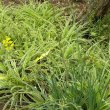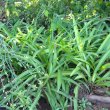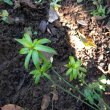| Botanical Name |
|
| Family |
Liliaceae - The lily family. |
| Pronunciation |
kloh-roh-FY-tum com-OH-sum |
| Common Name(s) |
English: Hen and chickens; Spider plant
Afrikaans: Hen-met-kuikens
IsiXhosa: ujejane; isicakathi
|
| Plant Group |
- Bulb / Corm / Rhizome / Tuber / Epigeal bulb Bulbs: are made up of fleshy scales as in an onion
Corm: a short, swollen, underground stem that is hard and not fleshy as in a gladiolus
Tuber: a solid, fleshy, underground, storage organ as in a potato
Rhizome: an underground, horizontal, swollen stem at the base of the plant as in an iris
Epigeal bulb: bulbs that rest above the ground with only the roots anchoring the plant to the earth as in albuca
- Ground Cover A plant with a low-growing, spreading habit, grown specifically to cover the ground.
- Perennial A plant whose life cycle lasts for three or more seasons.
|
| Plant Size |
- Small to Medium
| Tree | 8m to 15m |
| Shrub | 75cm to 1m |
| Perennial/ground cover | 20cm to 40cm |
| Bulb | 30cm to 40cm |
| Succulent | 20cm to 40cm |
|
| Position |
- Canopy Shade Canopy shade is found below closely grown trees where some light filters through. Ideal for the protection of herbaceous plants.
- Deep / Full Shade Shade below spreading evergreen trees where sun's rays are unable to penetrate the canopy at any time. For light sensitive plants
- Light or Dappled Shade Found below trees with sparse, open foliage. Ideal for the protection of herbaceous plants.
|
| General Information |
- Drought Tolerance: Moderate The plant is moderately adapted to arid conditions and can survive short periods of drought and high temperatures without extra water.
- Evergreen Plants that have leaves all year round.
- Frost: Tender A plant that will not survive any frost or low winter temperatures.
- Water Moderate These plants will need some extra watering compared to water-wise plants. Plant them together, in at least some shade and in a convenient proximity to the house so that grey water can be utilised during times of drought.
|
| Specific Information |
Chlorophytum comosum, as it grows in the wild, is not variegated, and the distribution information refers only to the 'Green Hen And Chickens', being the non-cultivated plant.
The grass-like, leaves of Chlorophytum comosum brighten up a shady area. These plants will survive some drought, but only really look attractive if watered regularly. These plants have fleshy, tuberous roots about 5 to 10 cm long. When in flower, the plant produces long, thin stems which carry flowers, as well as plantlets at the tip of the stem. A single plant with a few of these stems will soon become a mother plant surrounded by a flock of babies - hence the name 'hen and chickens'. Frost will kill the leaves, but mild frost will not damage the roots.
This plant has become naturalised in tropical and sub-tropical areas all over the world and in many cases has become invasive.
|
| Ad Break |
|
| Flowers |
| Description |
small, star-shaped, relatively insignificant
|
| Season |
- All Year Plants will seldom bloom for the entire season as given in the list, but should flower during a period within these parameters.
|
| Colour |
|
| Growth Rate |
- Very Fast Specifying growth rate can be very misleading as there is considerable variation of growth rate depending on type and species of plant, available water, supplementary feeding, mulching and general care, as well as the plants suitability and adaptability to the garden environment.
|
| Plant Uses |
- Container Trees, shrubs and ornamental species that can adapt to growing in a restricted environment.
- Filler Either a fast growing tree or shrub used temporarily to fill in an area while the permanent plants grow to a desired size, or a plant used to fill gaps in borders or beds.
- Foliage Plant Plants grown because their foliage is colorful or unique. Many of these plants have insignificant flowers.
- Ground Cover Low-lying plants that spread fast, require minimal maintenance, and cover large expanses or bare areas between bulbs or shrubs. They provide protection from erosion and drought and improve the visual appearance of the garden.
- Mass Planting Plants useful for filling a large area with just one or a few kinds of plants spaced close together. Creates a bold, dramatic effect and to reduces maintenance.
- Pioneer for new gardens A very fast growing plant, able to withstand hardship, that can be used to populate land that has recently been cleared of natural vegetation. These plants pave the way for slower-growing species by adding nutrients to the soil and creating leaf litter.
- Pot Plant A plant that needs a protected environment on a patio or indoors.
- Stabilize Banks Plant is used to prevent soil erosion because their roots will form a mat that stabilizes the soil and keeps it from washing away in heavy rains.
- Water Features These plants may have dramatic, lush foliage or graceful form. They do not shed excessive leaves and do not have invasive root systems.
|
| Distribution and Habitat |
in the Western Cape, Eastern Cape, KwaZulu-Natal, Limpopo, and Mpumalanga, and northward to north Africa, in frost free coastal areas
|
| Planting Suggestions |
Plant at any time of the year, about 30cm apart, in a shady place. Add compost and water regularly for lush growth. Mulch to retain moisture. Remove flower stems occasionally to prevent the area from being overgrown or becoming too untidy. If grown in a pot, fertilise regularly, bearing in mind that the mother plant has to feed all the little chickens.
|
| Medicinal Uses |
|
| Ad Break |
|








Discuss this plant
Share knowledge, ask a question or give an experience.